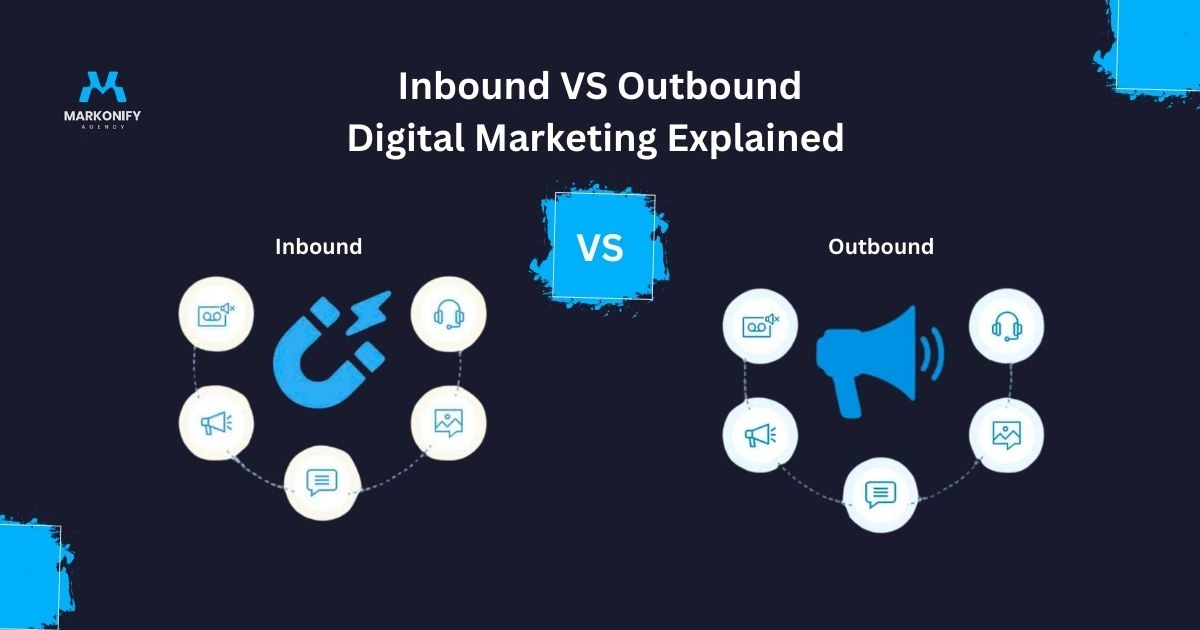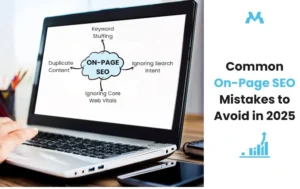Should you attract customers or chase them?
That simple question sits at the heart of all marketing strategies.
In today’s competitive digital landscape, businesses have two core approaches to reach their audience: inbound marketing and outbound marketing. One pulls people toward you through valuable content. The other pushes your message out to get attention.
In this blog, we’ll explain what both strategies are, compare them side by side, explore their pros and cons, and help you choose the right fit for your business.
What is Inbound Digital Marketing?
Inbound marketing is a strategy designed to attract potential customers by offering valuable, relevant, and helpful content instead of pushing sales messages.
It’s about being found by the customer, rather than finding them yourself.
The Core Goal:
- Attract the right audience
- Engage them with meaningful content
- Convert them into leads and loyal customers
- Inbound focuses on solving problems, educating, and creating content that matches what people are already searching for.
Examples of Inbound Marketing:
- Blog posts and SEO optimized articles
- YouTube tutorials or educational videos
- Engaging social media content
- Free downloadable guides or eBooks
- Email newsletters packed with tips and updates
Inbound marketing is value-first and often builds stronger, long-term relationships.
What is Outbound Digital Marketing?
Outbound marketing is the opposite. Instead of waiting for people to find you, you actively push your message to them, whether they’re interested or not.
It’s about getting attention fast often through paid promotions or direct outreach.
The Core Goal:
- Gain quick visibility
- Promote offers and brand awareness
- Drive immediate action
Outbound doesn’t wait for organic discovery. It uses paid tools and channels to reach people wherever they are.
Examples of Outbound Marketing:
- Google Ads or Facebook Ads
- Cold emails and sales calls
- Pop-up ads and banner displays
- Sponsored content or influencer shoutouts
- SMS campaigns or promotional blasts
Outbound is direct, fast-paced, and performance-focused but not always relationship-based.
Key Differences Between Inbound and Outbound Marketing
Here’s a quick breakdown of how they differ:
Feature | Inbound Marketing | Outbound Marketing |
Audience Approach | Attracts naturally through value | Interrupts to grab attention |
Cost Over Time | Lower long-term cost | High ongoing cost (especially ads) |
Relationship Building | Builds trust and brand loyalty | Less personal, short-term interactions |
Control & Targeting | Uses SEO, content strategy | Uses ad spend and demographic targeting |
Response Time | Slower but long-lasting results | Fast visibility and immediate feedback |
Pros and Cons of Each Strategy
Let’s take a closer look at what makes each approach work and where it may fall short.
Inbound Marketing Pros
- Cost-effective in the long run
- Builds deep, lasting customer relationships
- Attracts quality leads organically
- Enhances brand authority through helpful content
Inbound Marketing Cons
- Slower to see results
- Requires consistent effort and content creation
- SEO and ranking can take months to build up
Outbound Marketing Pros
- Fast visibility and quick reach
- Easy to scale with a clear budget
- Highly targeted (based on behavior, interests, location)
Great for product launches or sales campaigns
Outbound Marketing Cons
- Can be expensive over time
- Often gets ignored or blocked by users
- Trust level is lower among cold audiences
Which One Should You Use?
Your choice depends on your business type, goals, and marketing budget.
Use Inbound Marketing If:
- You’re a startup with limited budget
- You want steady, organic growth
- You’re focused on long-term branding
Your product/service requires education or explanation
Use Outbound Marketing If:
- You need immediate results (like leads or sales)
- You have a clear product and audience
- You’re launching a time-limited campaign
You’re testing market interest with quick feedback
Best Approach: Combine Both
In 2025, most successful businesses use a hybrid strategy:
- Use outbound tactics (like Facebook Ads) to drive traffic
- Send traffic to inbound content (like blogs or landing pages)
- Use remarketing to retarget warm visitors
- Capture emails or WhatsApp leads, then nurture through inbound tactics like newsletters or videos
The two strategies support each other outbound brings people in fast, while inbound builds a deeper connection.
Inbound and Outbound Marketing in Pakistan
Pakistan’s digital economy is growing rapidly. Businesses are using both strategies creatively across platforms like Facebook, Instagram, WhatsApp, TikTok, and Google.
Inbound Examples in Pakistan:
- Food bloggers sharing recipes that link to spice or utensil stores
- Clothing brands using Instagram Reels to show styling tips
- YouTube channels with real estate tips, driving traffic to agency websites
- Local health experts offering free eBooks to grow their email list
Outbound Examples in Pakistan:
- Facebook Ads promoting new lawn collections or shoes
- SMS campaigns from salons or ride-hailing apps
- Sponsored TikTok videos featuring beauty product demos
- Cold calls by real estate or insurance agents
Pakistani audiences are digitally active but cautious so trust-building matters. Inbound marketing helps nurture that trust, while outbound can generate quick leads or sales.
FAQs
Which is cheaper: inbound or outbound?
Inbound is cheaper in the long run. Once your blog or video ranks, it brings free traffic. Outbound costs more because you pay for every click or impression.
Can small businesses use both strategies?
Absolutely. Start with inbound by creating simple content, and run small outbound campaigns (like boosted posts) to speed up visibility.
Does SEO count as inbound?
Yes. SEO is a core inbound strategy. It helps people find your website naturally through search engines.
Is outbound marketing still effective today?
Yes but it needs to be smart and targeted. Generic outbound messages often get ignored. Personalized ads and high-value offers work best.
Is outbound marketing still effective today?
Yes but it needs to be smart and targeted. Generic outbound messages often get ignored. Personalized ads and high-value offers work best.
Conclusion – Attract or Interrupt? Choose Smartly
There’s no one-size-fits-all approach. Both inbound and outbound marketing have their strengths. Inbound helps you build a brand people trust. Outbound helps you get noticed fast.
The best strategy? Use both wisely.
- Use outbound ads to drive traffic
- Use inbound content to engage and convert
- Track your results and adapt as needed
- Use outbound ads to drive traffic




